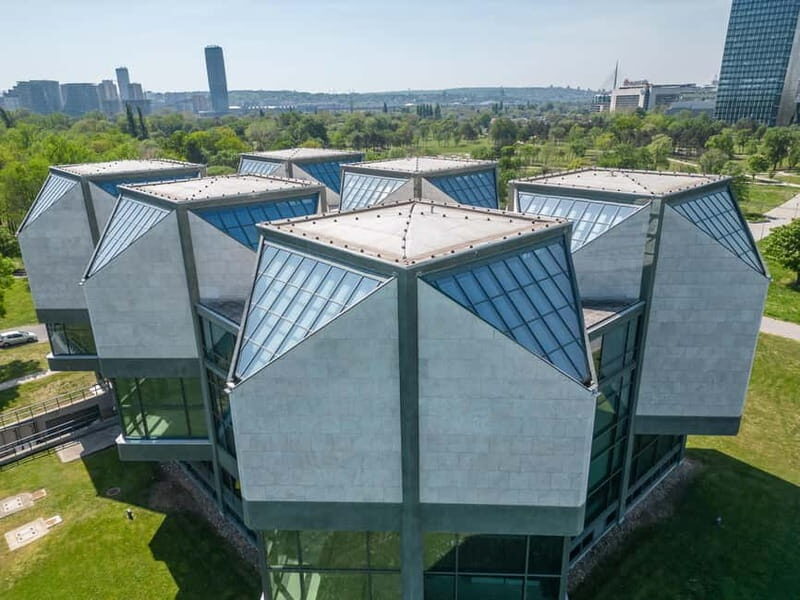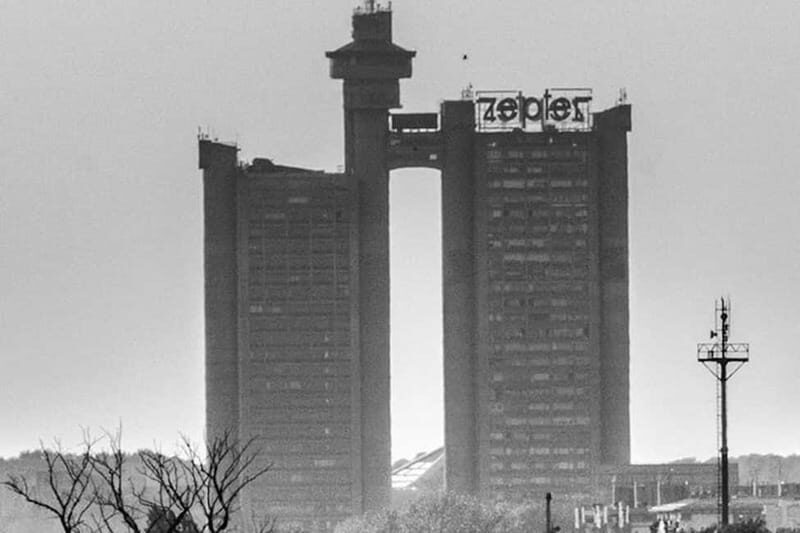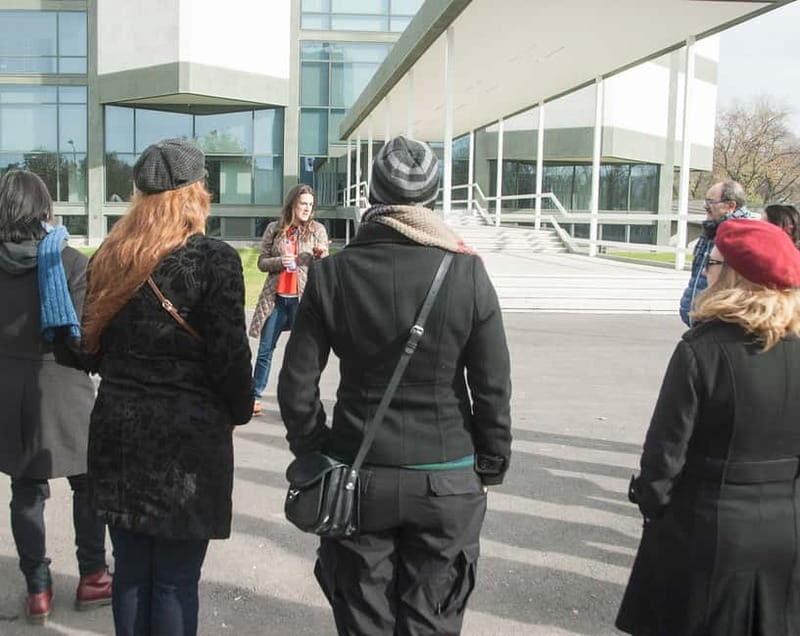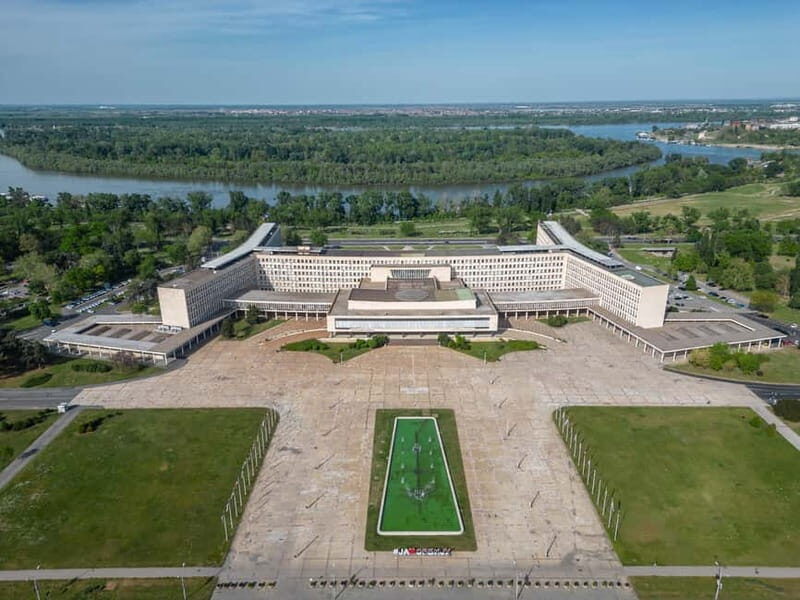Discover Belgrade’s Socialist Brutalist Architecture: A Deep Dive into a Unique Society

Imagine walking through a city where massive concrete structures tell stories of a bygone era—where socialist ideals and modernist styles converge in striking, sometimes surprising ways. This Belgrade: Socialist Brutalist Architecture Private Tour offers just that, giving you a close look at five standout buildings that showcase Yugoslavia’s distinctive approach to architecture from the 1960s to the 1980s.
Led by a passionate art historian, this 2.5-hour journey takes you from the Museum of Contemporary Art to the Sava Center, with stops that reveal not only architectural details but also the societal stories behind them. Whether you’re fascinated by brutalism, curious about Cold War politics, or simply love discovering lesser-known parts of a city, this tour delivers.
Two things we especially appreciate: first, the guide’s personal insights, since she actually lived in some of these buildings, adding an authentic touch. Second, the opportunity to photograph the Genex Tower, often called the “Western City Gate,” which is an iconic symbol of Yugoslav modernism. The only downside? The tour’s pace means you’ll want to pay close attention if you’re hoping to capture all the details in photos.
This experience is ideal for travelers interested in architecture, history buffs eager to understand Yugoslavia’s social experiment, or anyone curious about how architecture reflects society. It’s a thoughtful, engaging way to see Belgrade beyond the usual sights.
You can check availability for your dates here:Key Points

- Authentic Insights: The guide’s personal stories make the architecture come alive, offering perspective you won’t get from a guidebook.
- Architectural Diversity: From government buildings to housing blocks, the tour covers a broad spectrum of socialist modernism.
- Photo Opportunities: The Genex Tower and other buildings provide great angles for photography enthusiasts.
- Historical Context: Learn how architecture mirrored Yugoslavia’s political views and societal ambitions.
- Value for Money: Free entrance to featured sites and a knowledgeable guide make this tour an excellent investment.
- Accessible and Private: The tour is wheelchair accessible and tailored for private groups, ensuring a comfortable experience.
Prefer personalized experiences? Here are other private options we've covered in Belgrade
An In-Depth Look at the Tour: Architecture, Society, and Stories

Starting Point: Museum of Contemporary Art
Our journey begins in front of the Museum of Contemporary Art, a building that itself is a relic of socialist modernism. Constructed in the 1960s, its clean lines and marble facades challenge stereotypes of socialist architecture as merely utilitarian. Our guide, who grew up in a nearby socialist housing block, explains how this museum symbolizes Serbia’s complex relationship with modernism—bold and innovative, yet rooted in ideological ideals. We love the way the museum’s design reflects the era’s aspiration toward progress, and it’s a perfect starting point to understand the architecture style we’ll see throughout the tour.
Park of Friendship: The Heart of Yugoslav Diplomacy
A short walk takes us to Park of Friendship, where the Non Aligned Movement was born in 1961. Here, the leaders of 120 countries planted trees as symbols of peace—an inspiring reminder of Yugoslavia’s attempt to carve out a non-aligned path during the Cold War. It’s a small park, but packed with meaning, and our guide explains how the buildings and design here embody ideals of internationalism and unity. It’s a peaceful spot that contrasts sharply with the imposing structures we’ll see later.
More Great Tours NearbyPalace Serbia: A Political Statement
Next, we pass by the Palace Serbia, a government building that tells a story of Yugoslavia’s diplomatic balancing act. Construction began during a period of shifting allegiances—initially designed with Soviet influences, then reoriented as Yugoslavia moved away from Moscow’s grip. Our guide shares her firsthand knowledge of how this building reflects Yugoslavia’s political turbulence. We appreciate the way architecture here is more than just form—it’s a statement of resilience and independence.
- Belgrade: Sightseeing Boat Cruise with Drinks
- Northern Serbia: Sremski Karlovci and Novi Sad Full-Day Tour from Belgrade
- Day Trip from Belgrade: Gems of Eastern Serbia
- Belgrade Nightlife Bar Pub Club Crawl with Drinks
- Belgrade Big Tour: Top Attractions and Belgrade Neighborhoods
- Sunset Kayak Adventure in Belgrade
The Genex Tower: Modernist Masterpiece
No visit to Belgrade’s socialist architecture would be complete without a stop at the Genex Tower, also known as Western City Gate. Standing 30 floors tall, it’s one of the most photographed buildings in the city and a favorite among architecture enthusiasts. Our guide explains that it was the first ‘smart’ building in the Balkans and has won international acclaim for its brutalist design. We love the chance to snap photos from various angles, as the tower’s bold, geometric forms are mesmerizing.
She also breaks down brutalism as a style—substantial, raw concrete, sculptural forms—used here not just for function but to make a statement of strength and modernity. Interestingly, the Genex Tower was associated with the Genex company, a Yugoslav enterprise competing on a global scale, which challenges the stereotype that socialist economies were less innovative.
Housing Block No. 23: Daily Life in Socialist Belgrade
Our next stop is Blok 23, a well-preserved example of socialist housing. It includes not just apartment blocks but also public amenities like a school, kindergartens, artist studios, and a small shopping mall—a mini city within a city. Our guide shares personal stories of her childhood here, describing the community spirit of the 60s and 70s, and how social housing was designed to be more than just a place to live—it was meant to foster social cohesion.
She also candidly discusses the less rosy side of life in the 1990s, giving us a balanced perspective. We appreciate the detailed explanation of urban planning ideology—placing green spaces and communal facilities at the core of socialist city design.
The Sava Center: A Record-Breaking Congress Hub
Our final stop is the Sava Center, a massive congress hall completed in 1977. It set records for speed of construction and was even nominated for the Pritzker Architectural Prize. It hosted significant events like the OSCE conference and the Non Aligned Summit, but it also became historically significant as the venue for the last congress of Yugoslavia’s communist party in 1990.
Standing in front of this colossal structure, you can’t help but think about how architecture often marks the political trajectory of a society. The guide reminds us that this building is not just a monument to past glory but also a symbol of transitions and upheaval.
Practical Details: What to Expect and Why It Matters

Duration and Group Size: At 2.5 hours, the tour is concise but packed with information. It’s a private experience, which means the guide can tailor her stories and answer your questions thoroughly. We found this intimacy to be a huge plus, allowing for a more genuine connection and personalized insights.
Meeting Point and Accessibility: Starting at the Museum of Contemporary Art, the tour is easy to find. It’s wheelchair accessible, making it suitable for travelers with mobility needs. The ending point at Sava Center ensures a logical flow, with options to explore further or catch a taxi back into the city.
Cost and Value: Entrance fees are included in the price—since the buildings visited are free to enter—making this a good value overall. The guide’s expert commentary and personal stories add depth that you just can’t get from self-guided walks or reading alone.
Best for: Architecture aficionados, history buffs, and curious travelers who want an authentic, insightful look into how architecture reflects society. It’s also perfect for anyone wanting to go beyond typical sightseeing and gain a nuanced understanding of Yugoslavia’s unique social and political landscape.
The Sum Up: Who Will Love This Tour?
If you have a fascination with architecture that defies stereotypes, this tour offers a chance to see Belgrade through a different lens. It’s especially suited for travelers who value expert guides with personal connections to the buildings they discuss—here, the guide’s lived experience adds richness to every story.
The tour also appeals to those interested in post-war societies, and how architecture was used to express ideals of progress, unity, or resilience. The combination of visually striking structures and stories about their place in society makes this a memorable experience.
For anyone eager to explore a side of Belgrade that’s often overlooked, but deeply rooted in the city’s identity, this tour is a smart choice. It’s perfect for a short but meaningful exploration that leaves you with a new appreciation for the concrete giants and social visions of Yugoslavia.
FAQ
Is this tour suitable for wheelchair users?
Yes, the tour is wheelchair accessible, making it possible for travelers with mobility needs to enjoy the experience.
How long does the tour last?
It lasts approximately 2.5 hours, providing a thorough yet manageable exploration of Belgrade’s socialist architecture.
Do I need to reserve in advance?
Yes, reservations are recommended, especially since it’s a private tour. You can cancel up to 24 hours beforehand for a full refund.
Are entrance fees included?
Yes, all entrance fees to the venues we visit are included in the tour price.
What languages is the tour offered in?
The tour is available in English and Italian.
Can I book this tour for a private group?
Absolutely, it’s designed as a private experience for groups seeking a personalized perspective.
What should I bring?
Comfortable walking shoes, a camera for photos, and an open mind to learn about Yugoslavia’s social and political history through architecture.
Is this tour good for families?
While primarily aimed at adults interested in architecture and history, families with older children or teenagers with an interest in social history would enjoy it.
Does the tour include transportation?
No, transportation is not included. You meet at the Museum of Contemporary Art and finish at the Sava Center.
What makes this tour stand out compared to other Belgrade experiences?
Its focus on socialist modernism and brutalist architecture, combined with a guide who has personal, lived experience, offers a uniquely authentic and insightful perspective.
This tour offers a rich, engaging look at Belgrade’s architectural and societal evolution, perfect for travelers eager to see beyond the surface and understand the stories etched into concrete.
You can check availability for your dates here:More Private Tours in Belgrade
More Tours in Belgrade
More Tour Reviews in Belgrade
More Belgrade experiences we've covered
- Belgrade: Lipstick and Lip Gloss Making Workshop
- Belgrade: Tufting Workshop with 100% wool
- E Scooter Craft Beer and Breweries tour
- Belgrade: City Highlights Tour with Wine Tasting
- Belgrade Bike tour
- Avala Mountain Tour
- Belgrade Beer tour with beer tasting and local craft brewery
- Belgrade: Guided Walking Tour
- Belgrade: Kosutnjak forest hiking tour
- Belgrade Fortress: Private Tour to See Big Picture
- Belgrade: Family-Friendly Guided Private Walking Tour
- Belgrade City Tour and Nikola Tesla Museum
